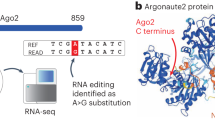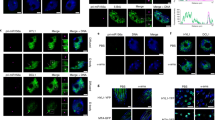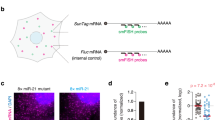Abstract
microRNAs (miRNAs) are small noncoding RNAs that play important regulatory roles in plants, animals and viruses. Measuring miRNA activity in vivo remains a big challenge. Here, using an miRNA-mediated single guide RNA (sgRNA)-releasing strategy and dCas9–VPR to drive a transgene red fluorescent protein, we create an miRNA sensor that can faithfully measure miRNA activity at cellular levels and use it to monitor differentiation status of stem cells. Furthermore, by designing sgRNAs to target endogenous loci, we adapted this system to control the expression of endogenous genes or mutate specific DNA bases upon induction by cell-type-specific miRNAs. Finally, by miRNA sensor library screening, we discover a previously undefined layer of heterogeneity associated with miR-21a activity in mouse embryonic stem cells. Together, these results highlight the utility of an miRNA-induced CRISPR–Cas9 system as miRNA sensors and cell-type-specific genome regulation tools.
This is a preview of subscription content, access via your institution
Access options
Access Nature and 54 other Nature Portfolio journals
Get Nature+, our best-value online-access subscription
$29.99 / 30 days
cancel any time
Subscribe to this journal
Receive 12 print issues and online access
$209.00 per year
only $17.42 per issue
Buy this article
- Purchase on Springer Link
- Instant access to full article PDF
Prices may be subject to local taxes which are calculated during checkout






Similar content being viewed by others
Data availability
RNA-sequencing data have been deposited in the Gene Expression Omnibus (GEO) under accession code GSE122683. All relevant sequences of primers and miRNA mimics have been provided in Supplementary Table 1. FPKM values are shown in Supplementary Table 2. Source data for Figs. 1d–f, 2a,c,d, 3c,f, 4b,d, 5e and 6b–d,f,g and Supplementary Figs. 2a,b, 3c,d, 4, 5b and 6b have been provided in Supplementary Table 3. Unprocessed gel images for Fig. 5c have been provided in Supplementary Fig. 7. All other data supporting the findings of this study are available from the corresponding author on reasonable request.
References
Bartel, D. P. Metazoan microRNAs. Cell 173, 20–51 (2018).
Chen, X. Small RNAs in development—insights from plants. Curr. Opin. Genet. Dev. 22, 361–367 (2012).
Cullen, B. R. Viruses and microRNAs: RISCy interactions with serious consequences. Genes Dev. 25, 1881–1894 (2011).
Hammond, S. M., Boettcher, S., Caudy, A. A., Kobayashi, R. & Hannon, G. J. Argonaute2, a link between genetic and biochemical analyses of RNAi. Science 293, 1146–1150 (2001).
Mourelatos, Z. et al. miRNPs: a novel class of ribonucleoproteins containing numerous microRNAs. Genes Dev. 16, 720–728 (2002).
Hutvagner, G. & Zamore, P. D. A microRNA in a multiple-turnover RNAi enzyme complex. Science 297, 2056–2060 (2002).
Zeng, Y., Yi, R. & Cullen, B. R. MicroRNAs and small interfering RNAs can inhibit mRNA expression by similar mechanisms. Proc. Natl Acad. Sci. USA 100, 9779–9784 (2003).
Doench, J. G., Petersen, C. P. & Sharp, P. A. siRNAs can function as miRNAs. Genes Dev. 17, 438–442 (2003).
Landgraf, P. et al. A mammalian microRNA expression atlas based on small RNA library sequencing. Cell 129, 1401–1414 (2007).
Jinek, M. et al. A programmable dual-RNA-guided DNA endonuclease in adaptive bacterial immunity. Science 337, 816–821 (2012).
Gasiunas, G., Barrangou, R., Horvath, P. & Siksnys, V. Cas9–crRNA ribonucleoprotein complex mediates specific DNA cleavage for adaptive immunity in bacteria. Proc. Natl Acad. Sci. USA 109, E2579–E2586 (2012).
Qi, L. S. et al. Repurposing CRISPR as an RNA-guided platform for sequence-specific control of gene expression. Cell 152, 1173–1183 (2013).
Cheng, A. W. et al. Multiplexed activation of endogenous genes by CRISPR-on, an RNA-guided transcriptional activator system. Cell Res. 23, 1163–1171 (2013).
Gilbert, L. A. et al. CRISPR-mediated modular RNA-guided regulation of transcription in eukaryotes. Cell 154, 442–451 (2013).
Maeder, M. L. et al. CRISPR RNA-guided activation of endogenous human genes. Nat. Methods 10, 977–979 (2013).
Perez-Pinera, P. et al. RNA-guided gene activation by CRISPR–Cas9-based transcription factors. Nat. Methods 10, 973–976 (2013).
Mali, P. et al. CAS9 transcriptional activators for target specificity screening and paired nickases for cooperative genome engineering. Nat. Biotechnol. 31, 833–838 (2013).
Kearns, N. A. et al. Functional annotation of native enhancers with a Cas9–histone demethylase fusion. Nat. Methods 12, 401–403 (2015).
Hilton, I. B. et al. Epigenome editing by a CRISPR–Cas9-based acetyltransferase activates genes from promoters and enhancers. Nat. Biotechnol. 33, 510–517 (2015).
Liu, X. S. et al. Editing DNA methylation in the mammalian genome. Cell 167, 233–247 e217 (2016).
Vojta, A. et al. Repurposing the CRISPR–Cas9 system for targeted DNA methylation. Nucleic Acids Res. 44, 5615–5628 (2016).
McDonald, J. I. et al. Reprogrammable CRISPR/Cas9-based system for inducing site-specific DNA methylation. Biol. Open 5, 866–874 (2016).
Nishida, K. et al. Targeted nucleotide editing using hybrid prokaryotic and vertebrate adaptive immune systems. Science 353, aaf8729 (2016).
Komor, A. C., Kim, Y. B., Packer, M. S., Zuris, J. A. & Liu, D. R. Programmable editing of a target base in genomic DNA without double-stranded DNA cleavage. Nature 533, 420–424 (2016).
Gaudelli, N. M. et al. Programmable base editing of A*T to G*C in genomic DNA without DNA cleavage. Nature 551, 464–471 (2017).
Chen, B. et al. Dynamic imaging of genomic loci in living human cells by an optimized CRISPR/Cas system. Cell 155, 1479–1491 (2013).
Chavez, A. et al. Highly efficient Cas9-mediated transcriptional programming. Nat. Methods 12, 326–328 (2015).
Gu, K. L. et al. Pluripotency-associated miR-290/302 family of microRNAs promote the dismantling of naive pluripotency. Cell Res. 26, 350–366 (2016).
Yan, Y. et al. Significant differences of function and expression of microRNAs between ground state and serum-cultured pluripotent stem cells. J. Genet. Genomics 44, 179–189 (2017).
Rao, P. K., Kumar, R. M., Farkhondeh, M., Baskerville, S. & Lodish, H. F. Myogenic factors that regulate expression of muscle-specific microRNAs. Proc. Natl Acad. Sci. USA 103, 8721–8726 (2006).
Gong, J. et al. Comprehensive analysis of human small RNA sequencing data provides insights into expression profiles and miRNA editing. RNA Biol. 11, 1375–1385 (2014).
Gilbert, L. A. et al. Genome-scale CRISPR-mediated control of gene repression and activation. Cell 159, 647–661 (2014).
Tsai, S. Q. et al. GUIDE-seq enables genome-wide profiling of off-target cleavage by CRISPR–Cas nucleases. Nat. Biotechnol. 33, 187–197 (2015).
Kuscu, C., Arslan, S., Singh, R., Thorpe, J. & Adli, M. Genome-wide analysis reveals characteristics of off-target sites bound by the Cas9 endonuclease. Nat. Biotechnol. 32, 677–683 (2014).
Chambers, I. et al. Nanog safeguards pluripotency and mediates germline development. Nature 450, 1230–1234 (2007).
Toyooka, Y., Shimosato, D., Murakami, K., Takahashi, K. & Niwa, H. Identification and characterization of subpopulations in undifferentiated ES cell culture. Development 135, 909–918 (2008).
Hayashi, K. et al. M.A. Dynamic equilibrium and heterogeneity of mouse pluripotent stem cells with distinct functional and epigenetic states. Cell Stem Cell 3, 391–401 (2008).
Carthew, R. W. & Sontheimer, E. J. Origins and mechanisms of miRNAs and siRNAs. Cell 136, 642–655 (2009).
Pritchard, C. C., Cheng, H. H. & Tewari, M. MicroRNA profiling: approaches and considerations. Nat. Rev. Genet. 13, 358–369 (2012).
Wang, X. W. et al. A protocol to build microRNA-inducible CRISPR–Cas9 platform. Protoc. Exch. https://doi.org/10.1038/protex.2019.001 (2019).
Acknowledgements
We thank members of the Wang laboratory for critical reading and discussion of the manuscript. We thank National Center for Protein Sciences Beijing (Peking University) for assistance with flow cytometry. This study was supported by The National Key Research and Development Program of China (2016YFA0100701 and 2018YFA0107601) and the National Natural Science Foundation of China (31471222, 91640116, 31821091 and 31622033) to Y.W.
Author information
Authors and Affiliations
Contributions
X.-W.W. and L.-F.H. performed all experiments with help from others. J.H. performed RNA sequencing analysis. L.-Q.L., Y.-T.C. and M.S. helped with constructing plasmids and cell culture experiments. All authors were involved in the interpretation of data. Y.W. conceived and supervized the project. Y.W. wrote the manuscript with help from X.-W.W. and L.-F.H.
Corresponding author
Ethics declarations
Competing interests
Two patent applications have been filed relating to the data presented here.
Additional information
Publisher’s note: Springer Nature remains neutral with regard to jurisdictional claims in published maps and institutional affiliations.
Integrated supplementary information
Supplementary Figure 1 MICR-ON activates transgene expression upon induction by miRNAs.
(a) FACS plot showing the gating strategy used in flow cytometry analysis to define RFP positive cells. (b) Dosage response of MICR-on RFP to miR-294 in miR-294-sensing-CRISPR-on Dgcr8-/- ESCs. Representative microscopic images for experiment 1 in Fig. 1d are shown. Scale bars: 100 μm. (c, d) RFP expression in miR-294-sensing and miR-20b-sensing CRISPR-on Dgcr8-/- ESCs upon transfection of 50 nM miR-294 or miR-20b mimics. (c) Representative microscopic images. Scale bars: 100 μm. (d) Representative flow cytometry scatter plots. Fraction of RFP positive cells using indicated cut-off (dotted line) is shown at the top right of each plot. (e) The RFP expression in the presence of different miRNAs in miR-294-sensing-CRISPR-on Dgcr8-/- ESCs. Shown are representative flow cytometry scatter plots of 3 independent experiments for Fig. 1e. Fraction of RFP positive cells using indicated cut-off (dotted line) is shown at the top right of each plot. For b-d, experiments were repeated twice independently with similar results.
Supplementary Figure 2 MICR-ON activates transgene expression upon induction by siRNAs.
(a) RFP expression in siHNRNPA0-sensing-CRISPR-on HEK-293T cells. Top: Representative microscopic images. Bottom: Relative fluorescence intensities. Data were normalized to siNC. Shown are mean ± SD, n = 3 independent experiments. Scale bars: 200 μm. (b) RFP expression in siPABPC1-sensing-CRISPR-on HEK-293T cells. Top: Representative microscopic images. Bottom: Relative fluorescence intensities. Data were normalized to siNC. Shown are mean ± SD, n = 3 independent experiments. Scale bars: 200 μm. All P values were calculated using two-tailed unpaired Student’s t-test. Statistical source data are provided in Supplementary Table 3.
Supplementary Figure 3 MICR-ON-RFP system can be used to track the differentiation status of stem cells.
(a) Flow cytometry analysis of undifferentiated, differentiated and miR-294 transfected differentiated cells. (b) Representative microscopic images showing RFP expression. Scale bars: 100 μm. Each experiment was repeated three times independently with similar results in a and b. (c) Mean fluorescence intensities of undifferentiated, differentiated and miR-294 transfected differentiated cells. Shown are mean ± SD, n = 3 independent experiments. (d) miR-1 expression is correlated with RFP intensity in differentiating miR-1 sensor C2C12 cells. Top, flow cytometry scatter plot and sorting gates. Bottom, correlation between miR-1 expression and RFP intensity in sorted cell populations. Shown is Pearson correlation coefficient. Three independent experiments were performed and similar results were obtained as shown. Statistical source data for c and d are provided in Supplementary Table 3.
Supplementary Figure 4 On- and off-target editing frequencies of MICR-BE.
Heat maps showing cellular C to T conversion percentages for each sample in the on-and off-targets loci. Shown is the mean value from 3 independent experiments. The percentages for the on-target sites are listed. Statistical source data are provided in Supplementary Table 3.
Supplementary Figure 5 MICR screen for the heterogeneity of miRNA activity in mouse ESCs.
(a) The design of screening strategy. (b) Representative flow cytometry histograms of RFP intensity in 10 different miRT-sensing-CRISPR-on mouse ESC cells. The experiment was repeated three times independently with similar results. (c) The % coefficient of variation (CV) of RFP intensity. Shown are mean ± SD, n = 3 independent experiments. Source data for b are provided in Supplementary Table 3.
Supplementary Figure 6 miR-21a displays heterogeneity of miRNA activity in mouse ESCs.
(a) GSEA for all conserved mRNA targets of miR-21a expressed in mouse ESCs (n=129). For x axis, genes are ranked based on the expression ratio of RFP low versus RFP high mouse ESCs. The nominal P value was determined by an empirical gene set-based permutation test. (b) qRT-PCR analysis of selected conserved miR-21a targets which are ranked 1–5 and 16–20 based on the FPKM fold change in RFP low versus RFP high mouse ESCs. Data were normalized to β-actin and then to RFP high ESCs. The bar indicates the average of 3 ESC samples. Each data point represents one ESC sample, independently cultured, sorted and processed separately in the same day. The experiments were performed twice independently with similar results (Data shown represent results from one experiment. Results for another set of experiment were included in Supplementary Table 3). (c) Scatter plot for the expression level of pluripotency related genes in RFP low versus RFP high mouse ESCs. Key pluripotency markers are indicated and labelled in red. All P values were calculated using two-tailed unpaired Student’s t-test. Source data are provided in Supplementary Table 3.
Supplementary Figure 7 Unprocessed gel images.
Shown are unprocessed gel images for Fig. 5c. The experiment was repeated three times independently with similar results as shown.
Supplementary information
Supplementary Information
Supplementary Figures 1–7 and legends for Supplementary Tables 1–3.
Rights and permissions
About this article
Cite this article
Wang, XW., Hu, LF., Hao, J. et al. A microRNA-inducible CRISPR–Cas9 platform serves as a microRNA sensor and cell-type-specific genome regulation tool. Nat Cell Biol 21, 522–530 (2019). https://doi.org/10.1038/s41556-019-0292-7
Received:
Accepted:
Published:
Issue Date:
DOI: https://doi.org/10.1038/s41556-019-0292-7
This article is cited by
-
Computational prediction and experimental validation identify functionally conserved lncRNAs from zebrafish to human
Nature Genetics (2024)
-
RNA structure: implications in viral infections and neurodegenerative diseases
Advanced Biotechnology (2024)
-
Exosomal miR-184 in the aqueous humor of patients with central serous chorioretinopathy: a potential diagnostic and prognostic biomarker
Journal of Nanobiotechnology (2023)
-
Techniques for investigating lncRNA transcript functions in neurodevelopment
Molecular Psychiatry (2023)
-
PERSIST platform provides programmable RNA regulation using CRISPR endoRNases
Nature Communications (2022)



